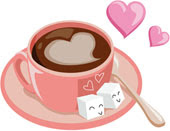photos: via teenee.com
Saturday, 1 May 2010
ที่มาของ ...'หม้อหุงข้าว'
หม้อหุงข้าว ประดิษฐ์ ขึ้นครั้งแรกในญี่ปุ่น เพื่อสนองความต้องการในประเทศ ในอดีตสตรีชาวญี่ปุ่นต้องหุงข้าวด้วยเตาถ่าน
ซึ่งต้องเสียเวลามานั่งเฝ้า และในช่วงสงครามโลกครั้งที่ 2 สตรีญี่ปุ่นต้องใช้แรงงานในการสงครามด้วย ความสะดวกรวดเร็วและประหยัดเวลาในการหุงข้าวจึงจำเป็นอย่างยิ่ง
ดังนั้นความสำเร็จในการประดิษฐ์หม้อหุงข้าวและเริ่มจำหน่ายขึ้นครั้งแรกในปีค.ศ.1956 จึงได้รับการตอบรับจากชาวญี่ปุ่นอย่างท่วมท้น
วิวัฒนาการหม้อหุงข้าวที่เก่าแก่ที่สุดเดิมมีชื่อเรียกว่า คามาโดะ มีมาตั้งแต่ยุคสมัยโคฟุน ค.ศ. 300-710 คามาโดะเป็นเตาดินเสริมด้วยอิฐหักเพื่อเพิ่มความแข็งแรงและทนทานต่อความร้อน ใช้ฟืนในการหุงต้ม นอกจากใช้หุงข้าวแล้วก็ยังนำมาต้มซุปถั่ว แต่มีข้อเสียคือเคลื่อนย้ายไม่ได้
ต่อมาสมัยนารา-เฮอัน ราวปีค.ศ.710-794 หม้อหุงข้าวพัฒนามาเป็น โอกิ-คามาโดะ สร้างขึ้นให้ใช้งานกลางแจ้ง และมีภาชนะแยกส่วนสำหรับบรรจุอาหารที่เรียกว่าฮากามะ สำหรับหย่อนลงในหลุมที่ด้านล่างมีกองฟืนสำหรับหุงต้ม
ภายหลังมีการประดิษฐ์ภาชนะบรรจุข้าวสำหรับหุงโดยเฉพาะ ลักษณะทรงรีทำด้วยโลหะ เรียกว่า โอกามา เรียกหม้อหุงข้าวชนิดนี้ว่า มูชิ-คามาโดะ
ปลายยุคสมัยไตโช กลางทศวรรษ 1920 เริ่มมีการทดลองผลิตหม้อหุงข้าวไฟฟ้าเป็นครั้งแรก ปลายทศวรรษ 1940 บริษัทมิตซูบิชิ อิเลคทริก ผลิตหม้อหุงข้าวที่มีหม้อและขดลวดนำความร้อนอยู่ภายใน ซึ่งเป็นรูปแบบที่ใกล้เคียงที่สุดกับหม้อหุงข้าวในปัจจุบัน แต่ก็ยังไม่สะดวกสบายนัก เพราะคนหุงต้องนั่งเฝ้าเนื่องจากยังไม่มีระบบอัตโนมัติ ภายหลังบริษัทมัตซูชิตะและโซนี่ผลิตหม้อหุงข้าวออกจำหน่าย แต่ก็ยังไม่ประสบความสำเร็จเช่นกัน
กระทั่งวันที่ 10 ธันวาคม 1956 บริษัทโตชิบานำหม้อหุงข้าวอัตโนมัติออกวางจำหน่าย 700 ใบ ประสบความสำเร็จมาก โตชิบาเริ่มผลิตหม้อหุงข้าวอีก 200,000 ใบ ในเวลาเพียง 1 เดือน อีก 4 ปี ต่อมาหม้อหุงข้าวเริ่มแพร่หลายไปเกือบครึ่งประเทศ
สาเหตุที่บริษัทโตชิบาประสบความสำเร็จในครั้งนี้ เนื่องจากเวลาที่รวดเร็วและแม่นยำในการหุงข้าว ที่ใช้เวลาเพียง 20 นาที หม้อหุงข้าวในยุคนั้นมี 2 ชั้น ชั้นนอกสำหรับบรรจุน้ำ ส่วนชั้นในสำหรับบรรจุข้าว รูปแบบนี้ใช้อยู่นานถึง 9 ปี จึงเปลี่ยนมาเป็นหม้อหุงข้าวในยุคปัจจุบัน
Friday, 30 April 2010
You Can Shine!
I just found this TV commercial (I've never seen it before either!) by chance today and I think the idea and the message is great although actually it should have had anything to do with "Pantene" the brand of shampoo ... but then again as it says: you can shine!
Why am I different from others?
Why ... do you have to be like others?
Wednesday, 28 April 2010
Ae Fond Kiss
Had we never lov'd sae kindly,
Had we never lov'd sae blindly,Never met-or never parted,We had ne'er been broken-hearted.
A fond kiss and then we part ....
broken-hearted?
Will this fond kiss one day be only just a kiss, a fond kiss?
It is just the matter of time then!
Robert Burns (1759-1796)
The Scots song "Ae Fond Kiss, and Then We Sever", by Robert Burns, is more commonly known as "Ae Fond Kiss". The song is Burns' most recorded song.
Lyrics: Written in a letter to Agnes M'Lehose, or 'Clarinda', (also known as 'Nancy' to her friends) in December 1791, when she left Burns, and Scotland, to follow her husband to Jamaica to try to save her marriage.
Ae Fond Kiss
Robert Burns
Ae fond kiss, and then we sever;
Ae fareweel, and then for ever!
Deep in heart-wrung tears I'll pledge thee,
Warring sighs and groans I'll wage thee.
Who shall say that Fortune grieves him,
While the star of hope she leaves him?
Me, nae cheerful twinkle lights me;
Dark despair around benights me.
I'll ne'er blame my partial fancy,
Naething could resist my Nancy:
But to see her was to love her;
Love but her, and love for ever.
Had we never lov'd sae kindly,
Had we never lov'd sae blindly,
Never met-or never parted,
We had ne'er been broken-hearted.
Fare-thee-weel, thou first and fairest!
Fare-thee-weel, thou best and dearest!
Thine be ilka joy and treasure,
Peace, Enjoyment, Love and Pleasure!
Ae fond kiss, and then we sever!
Ae fareweel alas, for ever!
Deep in heart-wrung tears I'll pledge thee,
Warring sighs and groans I'll wage thee.
Source: wikipedia
Exercise Wheel Bookcase
by GreenMuze Staff
Artist David Garcia has created an innovative Circular Walking Bookcase that lets you move around while browsing your favorite titles. The unusual bookcase allows readers to get some exercise while enjoying a good read.
A nice addition to this cool design innovation would be the ability to harvest the kinetic energy from the Circular Walking Bookcase and use it to power the room’s lights and/or coffee machine.
Source: GreenMuze
Visit: http://davidgarciastudio.blogspot.com/search/label/INSTALLATIONS
Artist David Garcia has created an innovative Circular Walking Bookcase that lets you move around while browsing your favorite titles. The unusual bookcase allows readers to get some exercise while enjoying a good read.
A nice addition to this cool design innovation would be the ability to harvest the kinetic energy from the Circular Walking Bookcase and use it to power the room’s lights and/or coffee machine.
Source: GreenMuze
Visit: http://davidgarciastudio.blogspot.com/search/label/INSTALLATIONS
Pet Chalet
This awesome Pet Chalet is the ideal place for furry friends to call home. Made of 100% recycled (and recyclable) cardboard and shipped flat, the stylish design will look pretty darn cute wherever you put it. Wonderful for cats, but perfect for other small friends like rabbits, ferrets, and really small dogs.
Each chalet also includes 3 cardboard balls for play, a textured cardboard carpet for paw massage and claw sharpening, and 4 fun plaques to decorate the entryway (a moose head, fish, bird, and banner).
Made in Canada.
Source: http://www.elsewares.com/
Monday, 26 April 2010
แผ่นโฆษณาไทยในอดีต 1
โฆษณา ถือเป็นอะไรที่ต้องใช้ความสร้างสรรค์ (แต่เดี๋ยวนี้บางอย่างก็ไม่ค่อยจะสร้างสรรค์สักเท่าไหร่)ความคิดที่แปลกๆ ที่สามารถทำให้ผู้ชมสนใจหันมาดูและท้ายที่สุด ทำให้ผู้ชมเป็นหนึ่งในลูกค้าของผลิตภัณฑ์หรือบริการนั้นๆได้
มาดูโฆษณาสมัยก่อนที่เป็นเพียงแค่แผ่นกระดาษธรรมดาๆ ไม่ค่อยจะมีสีสันเท่าไหร่ ภาษาที่ใช้รวมถึงการสะกดคำก็ต่างจากปัจจุบันเล็กน้อย เท่าที่สังเกตส่วนใหญ่จะเป็นเครื่องดื่มแอลกอฮอล์ น้ำอัดลม กับผลิตภัณฑ์แม่บ้านอย่างผงซักฟอก เป็นต้น
คุณเคยเห็นโฆษณาเหล่านี้มาก่อนหรือเปล่า
ภาพจากที่นี่ดอทคอม
Subscribe to:
Comments (Atom)



































